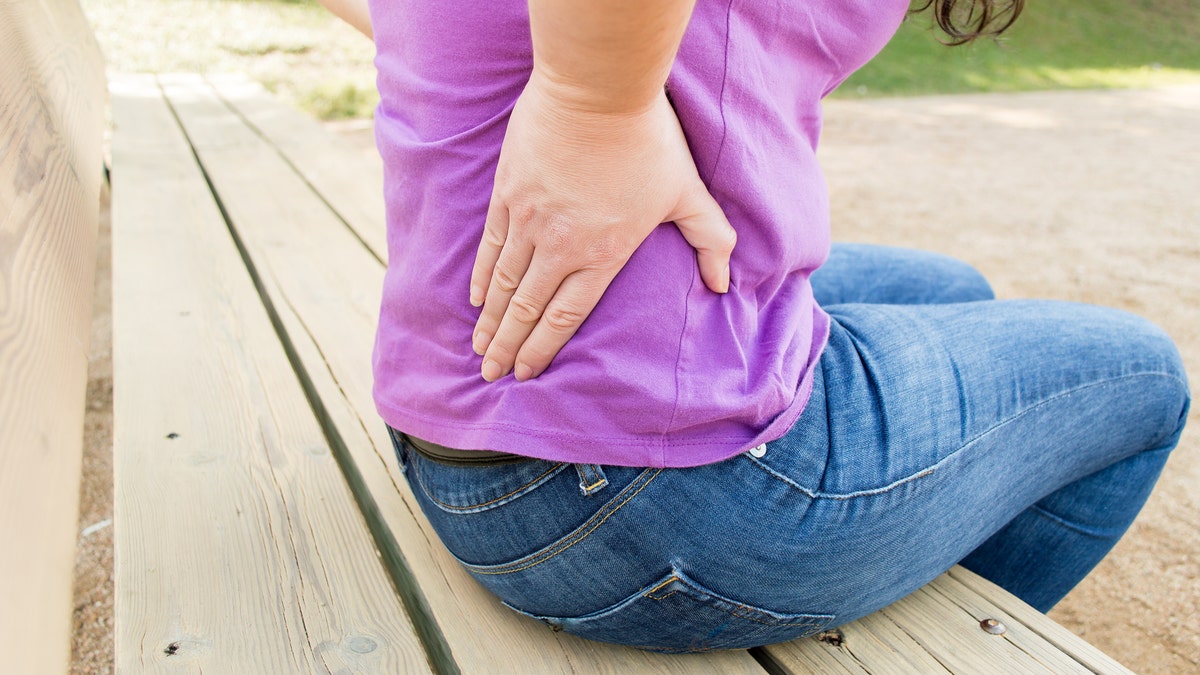
woman with a strong backache in the city park with her hand on the back (Manuel Faba Ortega)
Adapted from Tone Every Inch
Ah, it hurts so good (just keep telling yourself that). While sharp or shooting pain usually signals an injury worth listening to, feeling more general body soreness a day or two after a tough workout is perfectly healthy. Here’s how getting stronger works: When you push your body to do something it’s not used to, like use an 8-pound dumb-bell for an arm exercise you used to do with a 5-pounder, the extra push actually damages your muscle, creating little microtears.
More: 5 Foam Rolling Mistakes to Avoid
But don’t worry—that’s not a bad thing. The healing process that follows is what leaves your muscle stronger and more toned than when you began. Unfortunately, nothing but time can heal those sorenessinducing tears, but there are some things you can do to feel better in the meantime.
Do: Drink milk
Refueling ASAP after your workout with a combination of carbohydrates (to restock your muscles’ stores) and protein (to help muscles heal and grow) has long been accepted as the best way to avoid energy dips later in the day and make sure you’re on top of your game for tomorrow’s workout. Now a series of studies have suggested that milk specifically chocolate milk—might be the best choice, thanks to an ideal protein and carbohydrate blend that muscles can slurp up and use quickly to rejuvenate. Turns out sipping the white stuff (or its chocolaty cousin) after a strength workout might help to reduce muscle soreness over the subsequent 48 hours, perhaps because it seems to spur more rebuilding of muscles, say scientists at Northumbria University in Newcastle, England.
Don’t: Get in the hot tub
It may sound soothing, but hot water can actually increase inflammation and soreness in already-compromised muscles—and this goes for the heat brought on by any hot bath, hot tub, or even saunas and steam rooms. However, if you can’t resist the tub, toss in some Epsom salt (available at drugstores), which some believe helps reduce inflammation and pain.
More: The Top 15 Bloat-Busting Foods
Do: Bring on the ice
A bag of frozen peas can do wonders for easing inflammation and soreness, but for ultimate relief (after the initial shock) try an ice bath. A common trick of elite athletes, dumping a bag (or a couple trays) of ice into a bathtub filled with cold water can help to minimize soreness. The cold causes your blood vessels to constrict, which limits the increase in bloodflow to the damaged muscles initially (like kinking a hose). Then, when you get out of the cold tub and warm up, the blood gushes through with healing nutrients, helping to flush out some of the soreness-causing agents in the blood, explains Greg Ranalli, an athletic trainer in Wayne, Pennsylvania, who has published several studies on the effects of body cooling for athletes. Still prefer to sip your ice water, not sit in it? Try a cool shower instead of a hot one.
Don’t: Stretch (too much)
While some light stretching feels good on sore muscles thanks to what some experts describe as an analgesic effect, overdoing it could actually do more damage than good and even prolong your recovery, says David Geier, MD, an orthopedic surgeon and the director of sports medicine at the Medical University of South Carolina in Charleston.
More: 6 Exercise Excuses a Sweat Session Can Solve
Do: Pop an anti-inflammatory
If you want to, that is. NSAIDs, including ibuprofen (Advil), acetaminophen (Tylenol), and naproxen (Aleve), can help to ease soreness and inflammation, as well as lower levels of an enzyme that signals muscle damage. They can help you feel better, but they won’t get you back to your A-game any faster than simply waiting it out. If you are going to pop pills, stick to the recommended dosage on the bottle, and keep taking them as recommended for a couple of days. Take ’em just once and you won’t realize the inflammation-squelching benefits.
Do: Get a massage (or give yourself one)
While research is mixed, a good rubdown has been shown to reduce swelling and lessen soreness by as much as 30 percent, and we’re willing to take these odds. While an hour-long professional session is great if you have the time and the bucks to pay for it, studies suggest as little as 10 minutes on a sore muscle can do the trick. If you can’t get to a pro, a DIY leg massage is wholly within your (or your husband’s) talents: Alternate between gliding palms over the length of the muscle, kneading in small circles, and drumming up and down the length of the muscle to increase healing bloodflow.
More: Your Beach Body Boot Camp
This article originally appeared on RodaleWellness.com.




















